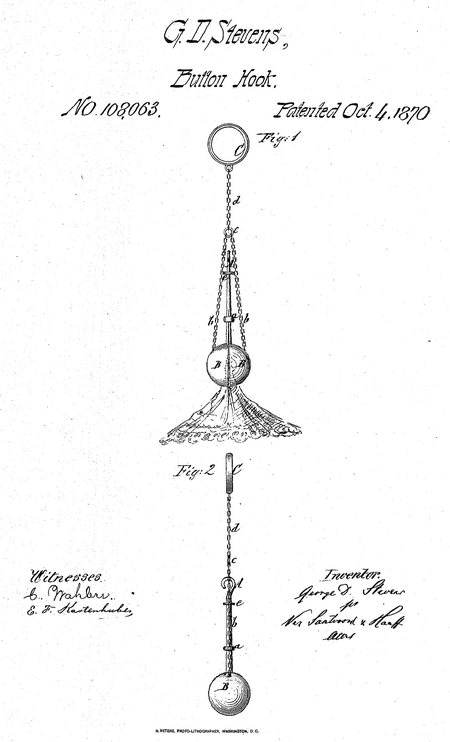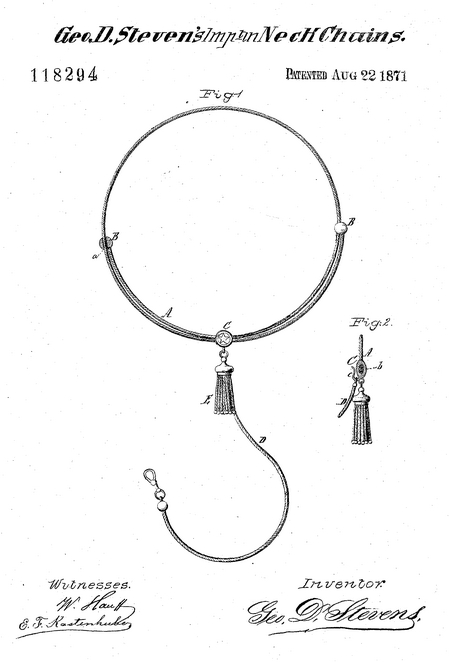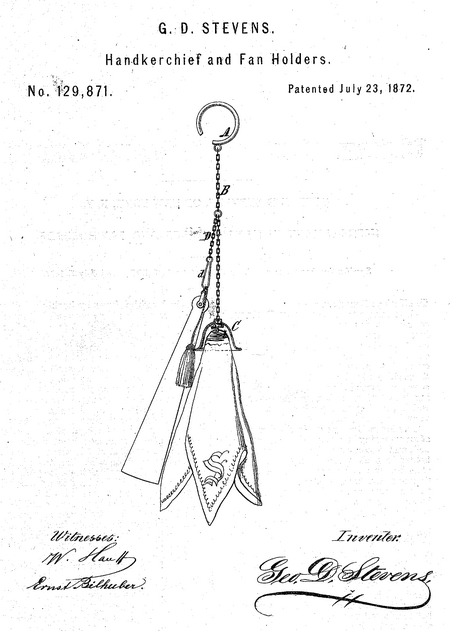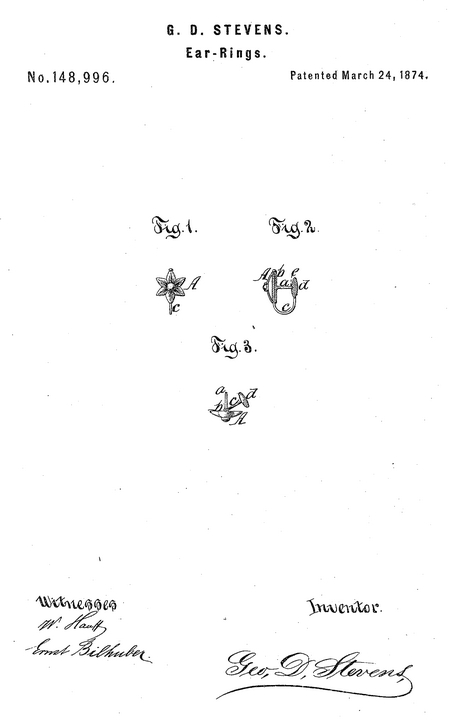George Dioclesian Stevens
- Born: 18 Feb 1836, Syracuse NY
- Marriage (1): Sarah Harriet Vanderbilt on 11 Oct 1863
- Died: 11 Sep 1881, East Orange NJ
General notes:
Jeweler
Events in his life were:
- He appeared on the census in 1870 in New York City NY. Listed as a jeweler.

- He was issued patent number 108,063 on 4 Oct 1870
GEORGE D. STEVENS, OF NEW YORK, N. Y.
Letters Patent No. 108,063, dated October 4, 1870.
IMPROVEMENT IN BUTTON-HOOKS AND HANDKERCHIEF-HOLDERS COMBINED.
To all whom it may concern:
Be it known that I, George D. Stevens, of the city, county, and State of New York, have invented a new and improved Button-Hook and Handkerchief -Holder Combined; and I do hereby declare the following to be a full, clear, and exact description thereof, which will enable those skilled in the art to make and use the same, reference being-had to the accompanying drawing forming part of this specification, in which drawing-Figure 1 represents a front view of this invention.
Figure 2 is a side view of the same.
Similar letters indicate corresponding parts.
This invention relates to a button-hook, the shank of which is split and connected to two jaws capable of clamping and retaining a handkerchief. From said jaws extend two chains, which connect at their ends with a branch chain attached to the suspension-ring, and said chains are also connected to a guide-ring sliding on the shank of the hook, so as to keep the device steady when it is to be used as a handkerchief-holder, and that, when the hook is to be used, the chains can be readily moved out of the way, so as not to interfere with the functions of the hook.
In the drawingó
The letter A designates a button-hook, the shank of which is split or partially made of two parts, each part being connected to a jaw, B, so that, by compressing the two parts of the shank, the jaws are also compressed, and a handkerchief, introduced between them, is firmly retained.
The jaws may be compressed by a sleeve, a, which slides on the shank of the hook, as shown in the drawing, or they may be compressed by any other suitable device.
From each of the jaws extends a chain, b, to a ring, c, which connects by another chain, d, with the suspension-ring C.
The chains bb are both connected to a guide-ring, e, which siides freely up and down on the shank of the hook.
By these means the device is held steady in an upright position if used as a handkerchief-holder, and, if the button-hook is to be used, the chains can be readily moved out of the way, so as as not to interfere with the function of the hook.
My device is particularly intended for fastening glove-buttons, and its convenience for that purpose will be readily appreciated, but the hook may also be used for buttoning gaiters, or for fastening buttons of any description.
What I Claim as new, and desire to secure by Letters Patent, isó
1. A button-hook and handkerchief-holder combined, as a new article of manufacture.
2. The guide-ring e, in combination with the chains bb, jaws B B, and hook A, substantially as set forth.
Geo. D. Stevens
Witnesses:
W. Hauff
E. F. Kastenhuber

- He was issued patent number 118,294 on 22 Aug 1871
GEORGE D. STEVENS, OF NEW YORK, N. Y.
IMPROVEMENT IN NECK-CHAINS.
Specification forming part of Letters Patent No. 118,294, dated August 22, 1871.
To all whom it may concern :
Be it known that I, George D. Stevens, of the city, county, and State of New York, have invented a new and useful Improvement in Neck-Chains; and I do hereby declare the following to be a full, clear, and exact description thereof, which will enable those skilled in the art to make and use the same, reference being' had to the accompanying drawing forming part of this specification, in which drawingó
Figure 1 represents a sectional plan of this invention. Fig. 2 is a transverse section of the same, the line x x, Fig. 1, indicating the plan of section.
Similar letters indicate corresponding parts.
This invention consists in the arrangement on a chain of two slides, one being fastened to each end of the chain, and each being provided with an aperture, through which the chain slides, in combination with a center slide forming a guide-for two strands of the chain, in such a manner that the chain can be extended to pass over the head of the person intending to wear it, and after it has been slipped over the head it can be drawn up round the neck to any desired degree, the ends of the chain being retained by the outside slides, while the center slide confines the two strands of the chain situated between the outside slides; and furthermore, said center slide forms an elegant ornament for the chain; also, in the arrangement of a hook or other fastening on the center slide of the neck-chain, the ends of which are secured to the outside slides, in combination with an additional chain provided with a device to engage with said. fastening, in such a manner that, by extending the neck-chain and fastening an additional chain to the center slide, an elegant watch-chain is obtained, which extends round the neck, and which can be lengthened or shortened at pleasure by means of the outside or end slides.
In the drawing, A designates my neck-chain, the ends of A which are secured to slides B B, and each of these slides is provided with a hole, a, to form a guide for the strand of the chain which is secured to the other slide. That portion of the chain A which is situated between the two slides forms two strands, which are confined in a suitable cavity, b, in the center slide 0, (see Fig. 2,) which slide is fitted on the chain, so that both strands can be readily drawn through it in either direction. On the back of the center slide is secured a hook, c, or any other suitable fastening, to which the additional chain D can be attached with ease and. convenience. This additional chain is intended to serve as the connection between the neck-chain and a watch. By pulling on those portions of the neck-chain beyond the end slides said chain is extended so that it can be conveniently passed! over the head of the person intending to wear the same, and by moving the end slides-back away from the center slide the chain is shortened until it fits the neck as closely as may be desirable. The center slide, being fitted loosely on the chain, can always be brought in the desired central posi-tion, and if the additional chain D is attached to said center slide my article serves the double-purpose of a necklace and of a watch-chain. The end slides, and particularly the center slide, can be made in any desired form or shape, and when properly made they form ornaments to the chain. With the center may also be combined a tassel, E, or any other trinket, locket, or ornament to suit the taste of the public.
What I claim as new, and desire to secure by Letters Patent, isó
1. The arrangement on a chain.of two slides, one being fastened to each end of the chain, and each being provided with an aperture through which the chain slides, in combination with an intermediate slide forming a guide for the chain, substantially as herein shown and. described.
2. The arrangement of a hook or other fastening on the center slide of the neck-chain A, in combination with an additional chain, provided with a device to engage with said fastening, substantially as set forth.
Geo. D. Stevens
Witnesses:
W. Hauff
E. P. Kastenhube

- He was issued patent number 129,811 on 23 Jul 1872
GEORGE D. STEVENS, OF NEW YORK, N. Y.
IMPROVEMENT IN HANDKERCHIEF AND FAN HOLDERS.
Specification forming part of Letters Patent No. 129,811, dated July 23, 1872.
To all whom it may concern:
Be it known that I, George D. Stevens, of the city, county, and State of New York, have invented a new and Improved Handkerchief and Fan Holder; and I do hereby declare the following to be a full, clear, and exact description thereof, which will enable those skilled in the art to make and use the same, reference being had to the accompanying drawing forming part of this specification, which drawing represents a sectional front view of my holder.
This invention consists in the arrangement of an open ring in combination with the chain, bell, and fastening device of a handkerchief-holder in such a manner that said handkerchief-holder can be conveniently adapted to fingers of different size, and worn suspended from a finger, or that it can be locked into a button-hole or other part of a dress, leaving both hands free. With the retaining-ring, the main chain, and the fastening device is combined a branch chain containing a hook to receive a fan. The fastening device consists of a bell containing a button with a spiral pin.
In the drawing the letter A designates an open ring, which connects by means of a chain, B, with a button, a, from which projects a spiral pin, b. Said chain is passed through a hole in the apex of a bell, C, so that when this bell is allowed to sink down to the position shown in the drawing it conceals the spiral pin; another fastening may, however, be substituted for the spiral pin, if desired. The ring A, being cut open, is rendered adjustable to fingers of different size; or, if it is desired to have both hands free, said ring can be attached to the dress by hooking it into a button-hole or into any convenient portion of the dress. The spiral pin b is similar in construction to the spiral shanks of shirt-buttons, with the exception, however, that it is provided with a sharp point, so that it can be readily made to enter the handkerchief, said point opening its own hole. By this spiral pin the handkerchief is securely retained and all danger that the same may become disengaged accidentally is avoided. From the main chain B extends a branch chain D, to the end of which is attached a hook, d, of any desirable construction, a snap-hook being used by preference. The object of this branch chain and hook is to combine with the handkerchief-holder a device for retaining a fan; or, if desired, any other articles, such as an ornament, may be suspended from said hook d.
By combining with the handkerchief-holder a fan-holder, the convenience and usefulness of my device are materially improved, since ladies are enabled thereby to carry their handkerchiefs and fans without encumbering their hands.
What I claim as new, and desire to secure by Letters Patent, isó
1. As a new article of manufacture, a handkerchief-holder and fan-holder combined, substantially in the manner set forth.
2. The open ring A, in combination with the chain B, bell C, and with a fastening device, substantially as described.
Geo. D. Stevens
Witnesses:
W. Hauff
E. F. Kastenhuber

- He was issued patent number 148,996 on 24 Mar 1874
GEORGE D. STEVENS, OF NEW YORK, N. Y.
IMPROVEMENT IN EAR-RINGS.
Specification forming part of Letters Patent No. 148,996, dated March 24, 1874; application filed June 19, 1873.
To all whom it may concern:
Be it known that I, George D. Stevens, of the city, county, and State of New York, have invented a new and useful Improvement in Ear-Rings; and I do hereby declare the following to be a full, clear, and exact description thereof, which will enable those skilled in the art to make and use the same, reference being had to the accompanying drawing-forming part of this specification, in which drawingó
Figure 1 represents a front view of my invention. Fig. 2 is a transverse section of the same. Fig. 3 is a side view of the same when the spring-guard is thrown open.
Similar letters indicate corresponding parts.
This invention consists in a swinging spring-guard, in combination with the body of the ear-ring, and with a supporting-pin, which extends from the back of said body in such a manner that when the spring-guard is thrown open, the supporting-pin can be readily passed through a hole in the lobe of the ear, and when the spring-guard is closed, it catches over the end of the supporting-pin, and thereby the ear-ring or pendant is securely held in position.
In the drawing, the letter A designates the body of my ear-ring, which may be made in any desired form or shape, with or without additional ornaments or pendants. From the back of this body extends a pin, a, which is pointed at its end, so that it can be readily passed through a hole in the lobe of the ear. In said back is also formed a tube, b, which forms the bearing for the shank c of the spring-guard d, said shank being curved and made of elastic, wire, or other suitable material, so that the guard can be turned up to the position shown in Fig. 2, or that it can be thrown open, as shown in Fig. 3. In the inner surface of the guard is a cavity, e, and if said guard is turned up to the position shown in Fig. 2, this cavity catches over the point of the supporting-pin a, and thereby the guard becomes locked.
By this arrangemement an ear-ring is produced which can be made cheap, and which can be attached to the ear and detached therefrom with little trouble, and at the same time when my ear-ring is secured in position, it is not liable to work loose accidentally.
It must be remarked that my spring-guard can be constructed in different forms, and it may be connected to the body of the ear-ring in various ways, which will readily suggest themselves to a skillful mechanic.
What I claim as new, and desire to secure by Letters Patent, isó
The spring-guard d having its bearing in a tube, b, so as to be turned on its axis, in combination with the supporting-pin a and earring A, all constructed and arranged to operate substantially as and for the purpose specified.
GEO. D. STEVENS
Witnesses:
W. Huaff
E. F. Kastenhuber
- He appeared on the census in 1880 in East Orange NJ. Listed as a jeweler.
George married Sarah Harriet Vanderbilt on 11 Oct 1863. (Sarah Harriet Vanderbilt was born on 19 Nov 1843 in Nyack NY and died on 4 Aug 1885.)
|







